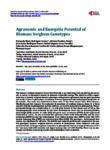Use este identificador para citar ou linkar para este item:
http://www.alice.cnptia.embrapa.br/alice/handle/doc/1023758Registro completo de metadados
| Campo DC | Valor | Idioma |
|---|---|---|
| dc.contributor.author | CASTRO, F. M. R. | pt_BR |
| dc.contributor.author | BRUZI, A. T. | pt_BR |
| dc.contributor.author | NUNES, J. A. R. | pt_BR |
| dc.contributor.author | PARRELLA, R. A. C. | pt_BR |
| dc.contributor.author | LOMBARDI, G. M. R. | pt_BR |
| dc.contributor.author | ALBUQUERQUE, C. J. A. | pt_BR |
| dc.contributor.author | LOPES, M. | pt_BR |
| dc.date.accessioned | 2015-09-11T11:11:11Z | pt_BR |
| dc.date.available | 2015-09-11T11:11:11Z | pt_BR |
| dc.date.created | 2015-09-11 | pt_BR |
| dc.date.issued | 2015 | pt_BR |
| dc.identifier.citation | American Journal of Plant Sciences, v. 6, p. 1862-1873, July 2015. | pt_BR |
| dc.identifier.uri | http://www.alice.cnptia.embrapa.br/alice/handle/doc/1023758 | pt_BR |
| dc.description | The biomass sorghum [Sorghum bicolor(L.) Moench], is an interesting crop considering the necessity to invest in alternative sources to generate renewable energy. The objective of this experiment was to identify sorghum biomass genotypes with greatest agronomic and energetic potential, and verify if there is phenotypic association between agronomic and technological properties in the hybrids. The study was conducted in three cities of the Minas Gerais State, Brazil (Lavras, Uberlândia and Sete Lagoas). We evaluated 16 genotypes of sorghum biomass, being 14 of them sensitive hybrids to photoperiod and two cultivars, as control, insensitive to photoperiod. The experimental design was a triple lattice 4 × 4, with plots formed by four linear rows of 5.0 m. The morphoagronomic traits evaluated for the three environments were: days to flowering (FLOW), plant height (PH), number of stalks (NS) and green mass production (GMP). In the experiment conducted in Lavras, we also evaluated the agronomic traits: stalk diameter (SD) and dry mass production (DMP) besides the technological traits: higher heating value (HHV), crude fiber (CF), neutral detergent fiber (NDF) and acid detergent fiber (ADF). The genotype × environment interaction was significant for all traits. The hybrids had superior performance compared to the control genotypes. Biomass sorghum hybrids, sensitive to photoperiod, when compared with commercial hybrids of forage sorghum, insensitive to photoperiod, had an average production of 34 tha?1 dry mass with 62% humidity and higher heating value of 4.400 Kcal/Kg. There was no phenotypic correlation between agronomic and technological traits evaluated. | pt_BR |
| dc.language.iso | eng | eng |
| dc.rights | openAccess | eng |
| dc.subject | Correlação fenotípica | pt_BR |
| dc.subject | Fonte alternativa | pt_BR |
| dc.title | Agronomic and energetic potential of biomass sorghum genotypes. | pt_BR |
| dc.type | Artigo de periódico | pt_BR |
| dc.date.updated | 2019-03-19T11:11:11Z | pt_BR |
| dc.subject.thesagro | Sorghum bicolor | pt_BR |
| dc.subject.thesagro | Bioenergia | pt_BR |
| dc.subject.thesagro | Recurso energético | pt_BR |
| riaa.ainfo.id | 1023758 | pt_BR |
| riaa.ainfo.lastupdate | 2019-03-19 -03:00:00 | pt_BR |
| dc.identifier.doi | 10.4236/ajps.2015.611187 | pt_BR |
| dc.contributor.institution | RAFAEL AUGUSTO DA COSTA PARRELLA, CNPMS. | pt_BR |
| Aparece nas coleções: | Artigo em periódico indexado (CNPMS)  | |
Arquivos associados a este item:
| Arquivo | Descrição | Tamanho | Formato | |
|---|---|---|---|---|
| Agronomicenergetic.pdf | 504.42 kB | Adobe PDF |  Visualizar/Abrir |









